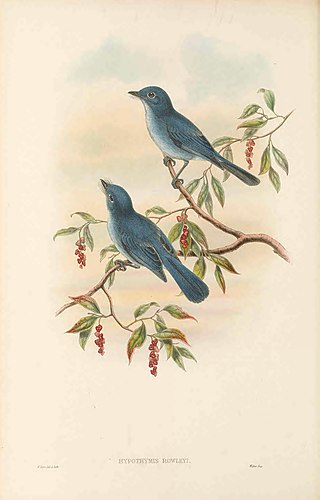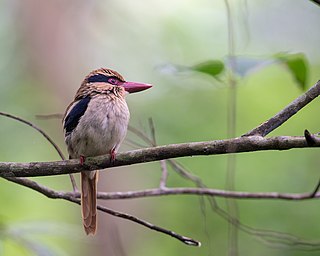
The Pachycephalidae are a family of bird species that includes the whistlers, shrikethrushes, and three of the pitohuis, and is part of the ancient Australo-Papuan radiation of songbirds. The family includes 64 species that are separated into five genera. Its members range from small to medium in size, and occupy most of Australasia. Australia and New Guinea are the centre of their diversity and, in the case of the whistlers, the South Pacific islands as far as Tonga and Samoa and parts of Asia as far as India. The exact delimitation of boundaries of the family are uncertain, and one species, the golden whistler, has been the subject of intense taxonomic scrutiny in recent years, with multiple subspecies and species-level revisions.

The grey shrikethrush or grey shrike-thrush, formerly commonly known as grey thrush, is a songbird of Australasia. It is moderately common to common in most parts of Australia, but absent from the driest of the inland deserts. It is also found in New Guinea.

The Sangihe hanging parrot is a small parrot endemic to the small island of Sangihe, north of Sulawesi, Indonesia.

The cerulean flycatcher is a medium-sized, blue passerine with bright cerulean blue plumage, a bare white orbital ring, dark brown iris, bluish black bill and pale blue-grey below. The young has a shorter tail and grey underparts. It is the only member of the monotypic genus Eutrichomyias. Although it resembles a monarch flycatcher, it is actually related to the fantails.

The elegant sunbird is a large, up to 12 cm long, Australasian sunbird in the genus Aethopyga. The male has an iridescent blue-green crown, shoulder patch and uppertail coverts, yellow bar across lower back, red ear coverts, olive back, yellow throat, red neck collar and yellow below. The female has a yellowish olive upperparts, scaly crown and yellow underparts.

Pachycephala is a genus of birds native to Oceania and Southeast Asia. They are commonly known as typical whistlers. Older guidebooks may refer to them as thickheads, a literal translation of the generic name, which is derived from the Ancient Greek terms pachys "thick" + kephale "head". This lineage originated in Australo-Papua and later colonized the Indonesian and Philippine archipelagos to the west and the Pacific archipelagos to the east.
The Sangihe scops owl is an owl species endemic to the Sangihe Island of Indonesia.

Lilac kingfishers are kingfishers in the genus Cittura, found in the lowlands of the Indonesia island of Sulawesi and the neighbouring Sangihe and Talaud Islands.

The Asian glossy starling is a species of starling in the family Sturnidae. It is found in Bangladesh, Brunei, India, Indonesia, Malaysia, Myanmar, the Philippines, Singapore, Taiwan (introduced), Cambodia and Thailand. Its natural habitats are subtropical or tropical moist lowland forest and subtropical or tropical mangrove forest. There is also a huge number of this species inhabiting towns and cities, where they take refuge in abandoned buildings and trees. They often move in large groups and are considered one of the noisiest species of birds. In the Philippines, it is known as kulansiyang, galansiyang, or kuling-dagat.

The shrikebills are the monarch flycatcher genus Clytorhynchus. The five species have long laterally compressed bills similar to true shrikes that give them their names. The genus is endemic to the islands of Melanesia and western Polynesia.

A shrikethrush, also spelled shrike-thrush, is any one of eleven species of songbird that is a member of the genus Colluricincla. They have nondescript, predominantly brown or grey, plumage, but are accomplished singers, their calls described as "strong, mellow and beautiful." Shrikethrushes are generally insectivorous, though have been recorded eating molluscs and berries. They build cup-shaped nests in the forks of trees.

The morningbird is a songbird species in the family Pachycephalidae.
The sooty shrikethrush is a species of bird in the family Pachycephalidae. It is found in the New Guinea Highlands. Its natural habitat is subtropical or tropical moist montane forests.

The maroon-backed whistler is a species of bird in the family Pachycephalidae. It is endemic to Sulawesi, Indonesia. Its natural habitat is subtropical or tropical moist montane forests. Some authorities have classified the maroon-backed whistler in the genus Pachycephala. Alternate names include the Rano Rano whistler and Raven's whistler.
Coracornis is a genus of birds in the family Pachycephalidae. The two species are found in Indonesia.

The black pitohui is a species of bird in the monotypic genus of Melanorectes in the family Pachycephalidae. It is found throughout the highlands of New Guinea. Its natural habitat is subtropical or tropical moist lowland forests.

The Sangihe white-eye is a species of bird in the white-eye family. It is endemic to Sangihe, Indonesia.
Frank Gerard Rozendaal was a Dutch ornithologist who in particular did research on the Southeast Asian avifauna. He also contributed to the taxonomy of bats. After field trips in Europe and the Near East he conducted expeditions to South, Southeast and East Asia from 1979 to 1991 where he discovered several new bird, bat and insect taxa.

The Sangihe pitta is a species of the pitta. It was considered a subspecies of the red-bellied pitta. It is endemic to Indonesia where it occurs in the Sangihe Islands. Its natural habitat is subtropical or tropical moist lowland forests. It is threatened by habitat loss.
The Sangihe lilac kingfisher is a species of kingfisher in the genus Cittura, endemic to the lowlands of the Indonesian island of Sangihe. It was previously considered a subspecies of the Sulawesi lilac kingfisher, but was split as a distinct species by the IUCN Red List and BirdLife International in 2014, and the International Ornithological Congress and Clements followed suit in 2022.















